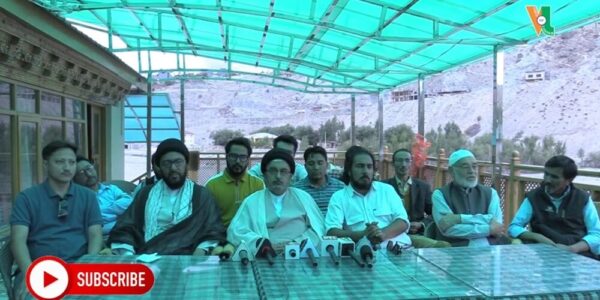What are the prospects for Sankoo becoming a district?
On August 26, 2024, at 11:22 AM, Home Minister Amit Shah announced on social media platform X that five new districts — Zanskar, Drass, Sham, Nubra, and Changthang — would be created in Ladakh.
As soon as the news was shared, celebrations began across Ladakh. The people in these areas, who had been asking for district status for a long time, were very happy, hoping this decision would bring them relief.
Ladakh had been divided into two districts, Leh and Kargil, in 1979, mainly based on religious differences, which led to rivalry between the two districts on religious lines. This new decision is expected to reduce those tensions and take Ladakh in a better direction.
* Click to Follow Voice of Ladakh on WhatsApp *
But the biggest problem was seen in the Sankoo subdivision, where people were upset that they were not given district status, even though the Sankoo subdivision deserved this status. If we look at the causes, we find that district status should be given to those areas where population density is high. In the case of the Sankoo subdivision, it is the area of Ladakh with the highest population.
The public representatives of the Sankoo Subdivision, including members from different political parties and religious groups, have asked the government to make their region a district. They made this request at a press conference held at the Tourist Facilitation Centre in Kargil, after Union Home Minister Amit Shah announced that Ladakh would be getting five new districts.
Their demand is backed by several compelling reasons, underlining why the Sankoo subdivision should be recognized as a district.
Geographical Significance
Sankoo’s geographical location and its relative distance from the Kargil district headquarters play a critical role in its candidacy for district status. Sankoo is located approximately 50 km from Kargil, with several villages under its jurisdiction lying even further away. For instance, Parkachik is 80 km from Kargil, and Panikhar is 65 km distant. Other villages like Itchoo, Umba, Achumbur, Tangole, Taisuru, Brakoo, Sangra, and Purtikchey also fall within Sankoo’s administrative boundaries and are similarly distant from Kargil headquarters. This geographical dispersion makes it challenging for residents to access essential government services, highlighting the need for closer administrative governance. Consequently, this argues that the creation of a district in Sankoo would enhance administrative efficiency and improve the delivery of public services.
Historical Perspective
Sankoo is not only geographically significant but also historically important. The subdivision is home to several heritage sites and monuments that reflect the rich cultural and historical legacy of the region. Kartse Khar, a historical area within Sankoo, is renowned for its 7th-century Maitreya Buddha statue and the graveyard of the ancient Muslim Queen Royall Khatoon. Additionally, the region hosts several sites of national and international importance, such as the 18th-century Rangdum Monastery, the Nun Kun View in Purtikchey, and the mountaineering spots in Tangole. Damsna, popular for picnics; Tai Suru/Panikhar, known for river rafting and rock climbing;Parkachik, renowned for glacier and mountain trekking.. These sites attract both national and international attention, reinforcing Sankoo’s importance as a cultural and historical hub within Ladakh. The establishment of a district in Sankoo would not only acknowledge its historical significance but also promote the preservation and development of these sites.
Demographical Significance
The demographic profile of Sankoo further substantiates the case for district status. According to the 2011 Census of India, Sankoo has a population of 40,548, making it one of the most densely populated areas in Ladakh. The subdivision comprises 36 villages and has a population density of 670 persons per square kilometer. Additionally, Sankoo boasts a higher literacy rate (53.98%) compared to the UT average, with male literacy at 64.27% and female literacy at 42.53%. The sex ratio of Sankoo stands at 900 females per 1,000 males, which is higher than the average for the former Union Territoryof Jammu & Kashmir. These demographic indicators suggest that Sankoo has the population size, density, and social infrastructure to warrant district status. Moreover, creating a district in Sankoo would address the administrative needs of its growing population and promote equitable development across the region.
Conclusion and Recommendations
The Sankoo subdivision stands out in comparison to other areas within Kargil due to its significant demographic and educational achievements. It boasts the highest literacy rate and the largest population in the Ladakh region. Given these metrics, along with the fact that Sankoo also has the highest population density, it is evident that the subdivision meets all the criteria necessary for district status.
However, despite these compelling reasons, the recent order issued by Home Minister Amit Shah on August 26, 2024, overlooked Sankoo when five new districts were created in Ladakh. This exclusion has understandably caused disappointment among the residents of Sankoo, who believe that their region deserved the same recognition as the other areas that were granted district status.
It is imperative to address this disparity and reassess the administrative status of Sankoo. As the Union Territory of Ladakh continues to evolve, it is crucial that all regions, particularly those as significant as Sankoo, are given due consideration in the process. Granting district status to Sankoo would not only acknowledge its demographic and educational prominence but also promote equitable development and prosperity across the region.
We therefore respectfully urge the Honorable Lieutenant Governor B.D. Mishra, Home Minister Shri Amit Shah, and Prime Minister Shri Narendra Modi to conduct a thorough review of this situation. The needs and aspirations of the people of Sankoo must be taken into account, and the decision to exclude the subdivision from district status must be reassessed. In conclusion, it also urges local political leaders and community representatives to unite in their advocacy for Sankoo’s recognition as a district. A collective effort is essential to rectify the current disparity and ensure that Sankoo’s legitimate claims are acknowledged and addressed.
9 Comments
Leave a Reply





Enlightening inputs to the hasty policy makers.
They better go through this article before giving their plan a final shape
Nice work sir.
The recommendation which has made by baqir sir some how very important to address or acknowledge through our political leaders i hope sankoo subdivision will get district status soon.
Very nice written from Baqir sir as sir highlighted the importance of district in sankoo division which is very genuine demand for sankoo .Hope it will consider the ignorance from our leaders
You have written so well, whether it’s the historical aspect or the other points,everything is mentioned clearly..hopefully sankoo gets district status soon
Nice work baqir sahab, optimistic thinking
The creation of Sankoo as a new district, separated from Kargil, is seen as a positive development by the local community. This change is expected to bring significant administrative and developmental benefits, with more focused governance and quicker implementation of government schemes tailored to Sankoo’s needs. The district status will likely improve infrastructure, including roads, healthcare, and education, crucial for regional growth. Additionally, it is expected to create new job opportunities in local administration and public services, making essential services more accessible. Overall, this move is a promising step toward a brighter future for Sankoo.
The creation of Sankoo as a new district, separated from Kargil, is widely seen as a positive development by the local community. This move is expected to bring significant administrative and developmental benefits to the region. As a new district, Sankoo will likely experience more focused governance, with faster implementation of government schemes and projects tailored to its unique needs. This can lead to better infrastructure, including improved roads, healthcare facilities, and educational institutions, all of which are crucial for the area’s growth.
The district status is also anticipated to create new employment opportunities in local administration and public services, providing much-needed jobs for residents. Additionally, the closer proximity of government offices will make essential services more accessible, reducing the need for long travels to Kargil.
Overall, the new district status for Sankoo is a promising step towards unlocking the region’s potential, fostering economic growth, and improving the quality of life for its residents. This development is expected to pave the way for a brighter, more prosperous future for the people of Sankoo.
Well, approving few more district for ladakh is an appreciative step via Modi Govt. Although , this step could be an irony to pollute the serenity of harmony, peace and caltural values; which could only be revealed through debate, discussion and putting the local political leaders into the spheres of questions.
Great work sir 👍.It is genuine demand for Sankoo.